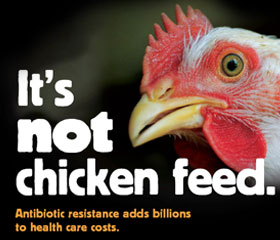Antibiotics: Animals in Agriculture
- In 2011, the CDC estimated that of the 48 million Americans who contracted foodborne illnesses, 128,000 were hospitalized and 3,000 died from a food related disease.
- Industrialized farms have been integrating antibiotics into our farm animal’s feed since 1946, where it was discovered that the drugs caused animals to effectively put on more weight as well as to grow at a more rapid rate. In today’s confined animal feeding operations or CAFOs, not only are antibiotics used to promote growth, but to also battle against the unsanitary environment that our livestock, fish, and poultry are raised in.
- According to the FDA, the animal’s living conditions are a breeding ground for illness and germs and are the reason why 28.8 million pounds of antibiotics are used in food animals annually. In addition, livestock and poultry alone account for as much as eighty percent of all antibiotic use in the United States.
- According to Sustainable Table, this extreme overuse is too much for the animals’ digestive systems. The excess antibiotic use causes nearly eighty to ninety percent of the antibiotics to pass through the animal and into the surrounding ecosystem in the form of concentrated fecal matter. In fact, more than one billion tons of excrement is produced yearly, filled with not only antibiotics, but antibiotic-resistant bacteria originating within the animals’ bowels. Once dumped into the environment, the antibiotics come across additional bacteria and create new resilient strands. These impervious strands then come in contact with the public, producing a sizeable amount of illnesses and diseases which are becoming quite costly.

- In 2009 alone, the National Academy of Sciences, a private, nonprofit establishment that offers expert advice on both national and international disputes, calculated that within the United States exclusively, antibiotic- resistant bacteria’s health care costs surpassed $4 billion. This value is a reflection of merely the hospital and pharmaceutical fees and does not account for other losses such as productivity and individual torment.

- With all of this evidence, the CDC has come to the conclusion that within the U.S., the leading cause of antibiotic resistance amongst foodborne pathogens is due to an overload of antibiotic use in animals used for food consumption.


I like the information that you have incorporated into your blog, very informative. I am also writing to promote PAMTA as a solution and believe that the need that you have portrayed in your blog can be used as a good advocate for it. I particularly like the 2011 CDC statistic, I have been looking for more relevant stats.
ReplyDelete